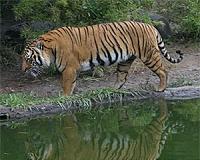| . |  |
. |
New York NY (SPX) Jul 13, 2010 Long before TV's campy Fantasy Island, the isolation of island communities has touched an exotic and magical core in us. Darwin's fascination with the Galapagos island chain and the evolution of its plant and animal life is just one example. Think of the extensive lore surrounding island-bred creatures like Komodo dragons, dwarf elephants, and Hobbit-sized humans. Conventional wisdom has it that they - and a horde of monster-sized insects - are all products of island evolution.
But are they? He and his colleagues have conducted a number of scientific studies comparing evolutionary patterns of island and mainland ecosystems, and the results refute the idea that islands operate under different, "magical" rules.
Man bites evolutionary dog "There is a tendency to believe that big animals become very small on islands, and small animals become very big, due to limited resources or lack of competition. I've shown that this is just not true, at least not as a general rule. Evolution operates on islands no differently than anywhere else." In a recent study reported in Global Ecology and Biogeography, Dr. Meiri and his colleagues looked at a theoretical optimum body size towards which mammals are expected to grow, on both island communities and on the mainland. Contemporary evolutionary thinking maintains that smaller island mammals will rapidly grow larger towards the optimal size, while bigger animals will rapidly shrink due to the constraints of competition on the islands. The researchers found that island isolation per se does not really affect the evolutionary rate, the rates of diversification of species, or the rate at which body size shifts in populations of island and mainland animals.
Reality Island? "We concluded that the evolution of body sizes is as random with respect to 'isolation' as on the rest of the planet. This means that you can expect to find the same sort of patterns on islands and on the mainland." Dr. Meiri attributes our widely held misperceptions about "dragons and dwarfs" to the fact that people tend to notice the extremes more if they are found on islands. The reason for science and mankind's fascination with island communities could boil down to "better press," says Dr. Meiri. If observers investigate human beings on 3,000 different South Pacific islands and all but one of the islands are populated by ordinary-sized people, they will tend to concentrate on the unique case. They forget about the other 2,999 islands in the South Pacific with normal-sized humans, and focus on the unusual. "I think it's purely a psychological bias," Dr. Meiri concludes. "It's just magical thinking. Nothing more." Fantasies about island habitats and the animals that live there are best left for movies, TV shows, and fantasy novels, he adds.
Share This Article With Planet Earth
Related Links American Friends of Tel Aviv University Darwin Today At TerraDaily.com
 Tiger countries meet in Indonesia to map rescue
Tiger countries meet in Indonesia to map rescueNusa Dua, Indonesia (AFP) July 12, 2010 Representatives from 13 "tiger-range countries" met in Indonesia on Monday to draft a global recovery plan ahead of a summit in Russia in September. "We're gathering here because we share concerns about the sustainability of tigers," Indonesian Forestry Minister Zulkifli Hasan said in an opening address to delegates on the resort island of Bali. "It is alarming that out of the nine tiger ... read more |
|
| The content herein, unless otherwise known to be public domain, are Copyright 1995-2010 - SpaceDaily. AFP and UPI Wire Stories are copyright Agence France-Presse and United Press International. ESA Portal Reports are copyright European Space Agency. All NASA sourced material is public domain. Additional copyrights may apply in whole or part to other bona fide parties. Advertising does not imply endorsement,agreement or approval of any opinions, statements or information provided by SpaceDaily on any Web page published or hosted by SpaceDaily. Privacy Statement |